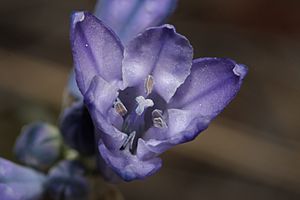Largeflower triteleia facts for kids
Quick facts for kids Largeflower triteleia |
|
|---|---|
 |
|
| Triteleia grandiflora in Wenas Wildlife Area, Washington | |
| Scientific classification | |
| Synonyms | |
|
Triteleia grandiflora, often called the largeflower triteleia or wild hyacinth, is a lovely flowering plant that grows in western North America. You can find it from British Columbia in Canada, south to northern California, and east into states like Idaho, Montana, and northern Utah. Sometimes, you might even spot it in Wyoming and Colorado, though these spots are more spread out.
About the Wild Hyacinth
This plant is a type of perennial herb, which means it lives for more than two years and comes back each growing season. It grows from a special underground stem called a corm. A corm looks a bit like a bulb and stores food for the plant.
Where it Grows
The wild hyacinth likes to live in many different places. You can find it in open grasslands, areas with sagebrush, and in both woodlands and forests. It's quite adaptable!
How it Looks
The Triteleia grandiflora has two or three long, thin leaves that grow from its base. These leaves can be up to 70 centimeters (about 2.3 feet) long.
A smooth, straight stem grows tall from the plant, reaching up to 75 centimeters (about 2.5 feet). At the top of this stem, you'll see a cluster of many flowers, arranged like an umbel. An umbel is when flower stalks all grow from the same point, like the spokes of an umbrella.
Each flower is shaped like a funnel and sits on a small stalk called a pedicel, which can be up to 4 or 5 centimeters long. The whole flower can be up to 3.5 centimeters (about 1.4 inches) long. It has six petal-like parts called tepals. The three inner tepals are a bit ruffled and wider than the outer ones. The flowers can be a deep blue color, or sometimes almost white, often with a darker blue line down the middle of each tepal. Inside the flower, there are six stamens, which are the parts that produce pollen. These stamens have either purple or yellow anthers at their tips.
Edible Parts
The corms of the Triteleia grandiflora are a food source for many wild rodents and livestock like cows or sheep. Long ago, Native Americans and early settlers also found these corms to be a good and tasty food source.


